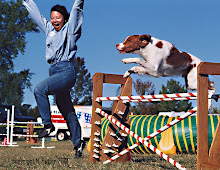In a past post, I discussed coprophagia in dogs.
Dr. Ben Hart, a board-certified veterinary behaviorist from UC Davis, did a study using internet surveys regarding this subject, and the results and conclusions were presented at the AVSAB annual meeting in 2012. He learned that as many as 16% of dogs ate stools frequently. 85% of these dogs at the feces of other dogs. Intact males were less likely to eat feces than neutered males or females (spayed or not). Diet did not influence this habit, so dogs are not likely to be eating feces to gain something that they are lacking nutritionally. 40% of Border Collies and Shetland Sheepdogs ate feces; no Poodles were reported to do so. Interestingly, 90% of the stools were eaten within 2 days of deposition.
Dr. Hart's conclusion from this study was that since dogs eat the stools of other dogs while they were relatively fresh, that coprophagia may have been a selected-for behavior because it provides a way to keep the den clean and protect puppies from intestinal parasites, which would not yet have matured to be at an infective stage.
Dr. Hart's study also found that deterrents (such as For-Bid, Deter-um, etc.) and food additives (pineapple, meat tenderizer) were effective only 0-2% of the time to prevent coprophagia. Neither punishment (yelling, electronic collars) nor reward based traning methods (clicker traning) were effective. The best solution was to pick up the dog promptly after it is deposited... or, perhaps, as Dr. Hart jokes, get an intact, male Poodle.
Friday, September 13, 2013
Thursday, September 5, 2013
Ideas for Post-Surgical Exercise Restriction
Dogs who have undergone surgery are often hard to keep quiet post-operatively. The same is true for dogs who have suffered an injury and need to be exercise-restricted.
The importance of rest during the healing period cannot be overstated; normal activity can lead to painful hematomas, seromas, malalignment of a fracture, exacerbation of or failure to heal from a soft tissue injury or worse. How can an owner make their active dog rest?
The importance of rest during the healing period cannot be overstated; normal activity can lead to painful hematomas, seromas, malalignment of a fracture, exacerbation of or failure to heal from a soft tissue injury or worse. How can an owner make their active dog rest?
- Consult with your veterinarian or rehabilitation specialist for the details regarding just how much activity is allowable given your pet's individual case. Does the dog have to be confined to a cage? Are leash walks allowed, and if so, what length leash, how far, how long, how often, and are hills ok? Is the dog allowed out in the yard with the other dogs? Is the dog allowed to be loose in the house, with or without the other dogs?
- Engage the mind. Play the brain games (Find It!, Shell Game) described in my last post on Cognitive Dysfunction: Behavior Modification. There are some commercially available dog games that are puzzles in which food is hidden. Practice sit-stays and down-stays. Teach your dog to balance something on his body, i.e., a toy on his nose, a treat on his paw. I taught my first dog, Marcus (seen with me in my profile picture) to start the balancing tricks with a 12-inch length of grosgrain ribbon (it did make a neat Christmas picture, as the ribbon was red). Note: please do keep the treats relatively small in size. If your dog is being exercise-restricted, he is not burning as many calories as normal. Let's not contribute to an obesity problem.
- Consider offering a stuffed Kong toy once or twice daily. You can plug the small end with peanut butter, stuff it with regular kibble or other goodies, pour in some dilute low-sodium broth, place upside down in a plastic up and freeze it. Kong also makes stuffing that can be squirted into a Kong or similar food-dispensing toy. Other alternatives for stuffing include squeeze cheese, cheese melted for a few seconds in the microwave and cooled, and small amounts of peanut butter.
- Chewing is a great way for dogs to burn energy. If your dog has not suffered through gastrointestinal surgery, consider offering something to chew. There are some toys that can be refilled, and if your dog can tolerate it, consider rawhide, bully sticks or pig ears (please supervise when these are given to make sure big pieces that could potentially cause an obstruction are not swallowed).
- If your dog is allowed to take walks, consider using a Gentle Leader headcollar. This will give you much better control over the pace at which your dog will walk. Please refer to prior post on the Gentle Leader.
- If your dog is inherently active, and you feel that you will need help taking the edge off a normally frenetic attitude, please discuss with your veterinarian the possible use of low-level oral sedatives.
Subscribe to:
Comments (Atom)
